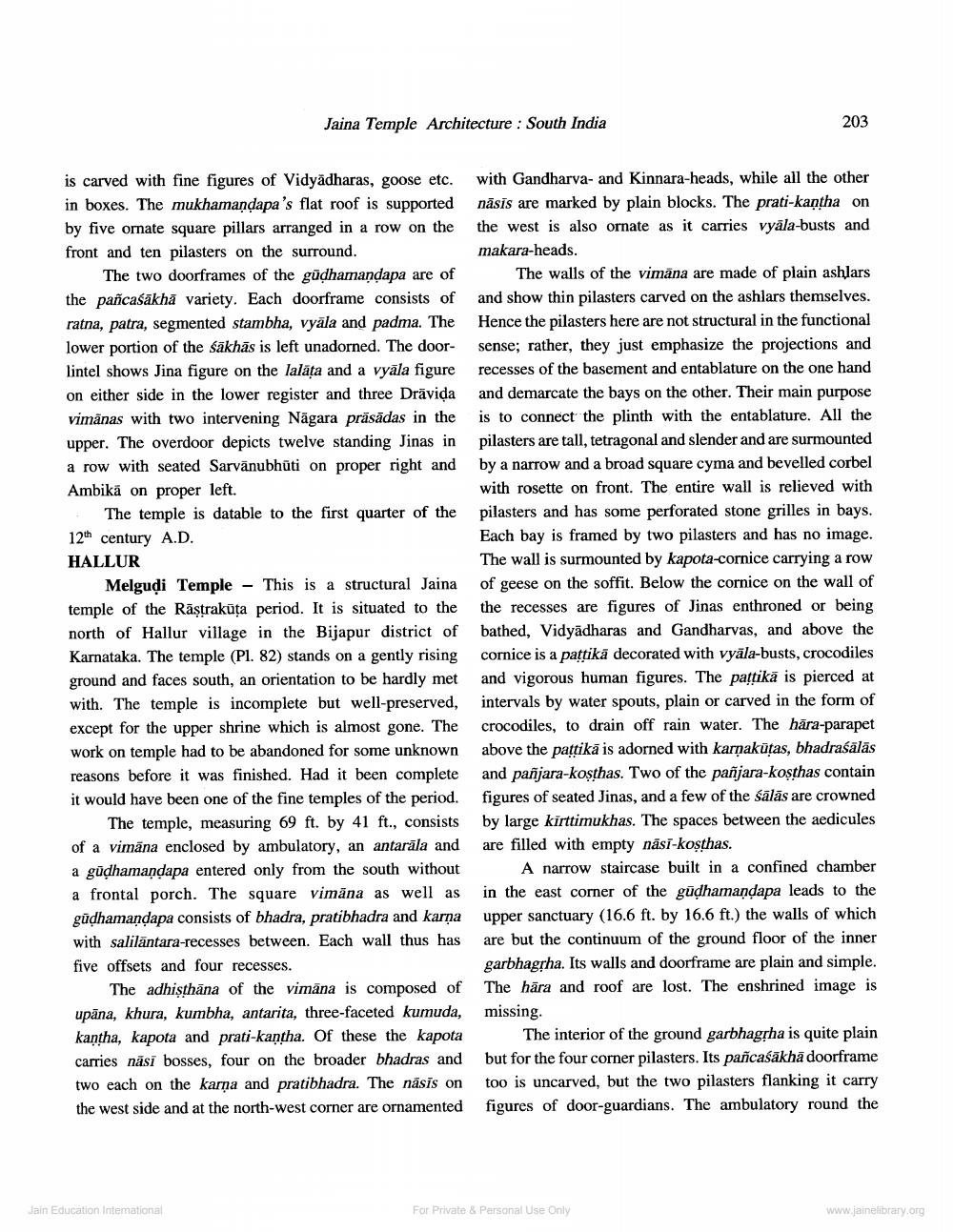________________
Jaina Temple Architecture : South India
203
is carved with fine figures of Vidyādharas, goose etc. in boxes. The mukhamandapa's flat roof is supported by five ornate square pillars arranged in a row on the front and ten pilasters on the surround.
The two doorframes of the gūdhamandapa are of the pañcaśākha variety. Each doorframe consists of ratna, patra, segmented stambha, vyāla and padma. The lower portion of the sākhās is left unadorned. The door- lintel shows Jina figure on the lalāta and a vyāla figure on either side in the lower register and three Drāvida vimānas with two intervening Nägara präsādas in the upper. The overdoor depicts twelve standing Jinas in a row with seated Sarvānubhūti on proper right and Ambika on proper left.
The temple is datable to the first quarter of the 12th century A.D. HALLUR
Melgudi Temple - This is a structural Jaina temple of the Rästrakata period. It is situated to the north of Hallur village in the Bijapur district of Karnataka. The temple (Pl. 82) stands on a gently rising ground and faces south, an orientation to be hardly met with. The temple is incomplete but well-preserved, except for the upper shrine which is almost gone. The work on temple had to be abandoned for some unknown reasons before it was finished. Had it been complete it would have been one of the fine temples of the period.
The temple, measuring 69 ft. by 41 ft., consists of a vimāna enclosed by ambulatory, an antarala and a gūdhamandapa entered only from the south without a frontal porch. The square vimāna as well as gūdhamandapa consists of bhadra, pratibhadra and karņa with salilantara-recesses between. Each wall thus has five offsets and four recesses.
The adhisthana of the vimāna is composed of upāna, khura, kumbha, antarita, three-faceted kumuda, kantha, kapota and prati-kantha. Of these the kapota carries nāsi bosses, four on the broader bhadras and two each on the karma and pratibhadra. The nāsis on the west side and at the north-west corner are ornamented
with Gandharva- and Kinnara-heads, while all the other nāsīs are marked by plain blocks. The prati-kantha on the west is also ornate as it carries vyäla-busts and makara-heads.
The walls of the vimāna are made of plain ashlars and show thin pilasters carved on the ashlars themselves. Hence the pilasters here are not structural in the functional sense; rather, they just emphasize the projections and recesses of the basement and entablature on the one hand and demarcate the bays on the other. Their main purpose is to connect the plinth with the entablature. All the pilasters are tall, tetragonal and slender and are surmounted by a narrow and a broad square cyma and bevelled corbel with rosette on front. The entire wall is relieved with pilasters and has some perforated stone grilles in bays. Each bay is framed by two pilasters and has no image. The wall is surmounted by kapota-cornice carrying a row of geese on the soffit. Below the cornice on the wall of the recesses are figures of Jinas enthroned or being bathed, Vidyadharas and Gandharvas, and above the cornice is a pattikā decorated with vyāla-busts, crocodiles and vigorous human figures. The pattika is pierced at intervals by water spouts, plain or carved in the form of crocodiles, to drain off rain water. The hāra-parapet above the pattikā is adorned with karnakutas, bhadraśālās and pañjara-kosthas. Two of the pañjara-kosthas contain figures of seated Jinas, and a few of the salās are crowned by large kirttimukhas. The spaces between the aedicules are filled with empty nāsi-kosthas.
A narrow staircase built in a confined chamber in the east corner of the gūdhamandapa leads to the upper sanctuary (16.6 ft. by 16.6 ft.) the walls of which are but the continuum of the ground floor of the inner garbhagsha. Its walls and doorframe are plain and simple. The hära and roof are lost. The enshrined image is missing.
The interior of the ground garbhagsha is quite plain but for the four corner pilasters. Its pañcaśākhā doorframe too is uncarved, but the two pilasters flanking it carry figures of door-guardians. The ambulatory round the
Jain Education Intemational
For Private & Personal Use Only
For Private & Personal use only
www.jainelibrary.org




